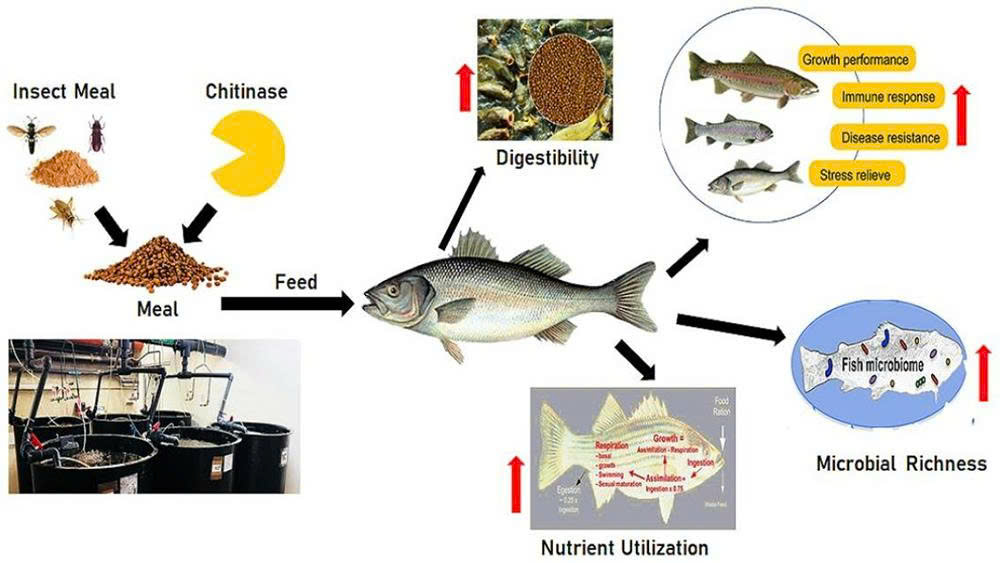Chitin, a nitrogenous polymer found in fishery waste, has potential applications in aquaculture. Chitinase, an enzyme that breaks down chitin, can convert it into usable forms and aid digestion in fish. Chitosan, a derivative of chitin, can improve fish's growth, immunity, and disease resistance. However, more research is needed to fully understand its efficacy and potential applications. This article analyzes the potential applications, benefits, and challenges of chitinase in aquaculture.
1. Enhanced nutrient utilization with chitinase
Chitinase is an enzyme that hydrolyzes chitin into digestible carbohydrates, which can be used in fish feed to increase the nutritional value. It breaks down chitin-containing biomass, such as marine organism waste, into simpler components, making them more bioavailable and easier to absorb in the animal's digestive tract. Chitin oligosaccharides can serve as prebiotics, promoting the growth of beneficial gut bacteria that play a role in nutrient absorption and overall gut health. Chitinase can also be used in the biocontrol of pathogenic fungi and harmful insects, contributing to disease management in aquaculture.
Incorporating chitinase in aquafeeds can increase chitin digestibility and nutrient digestibility, but the specific increase may vary depending on chitin intake and fish species. This can lead to reduced feed waste and improved feed conversion, leading to more sustainable and cost-effective farming. However, increasing microbial chitinase production is challenging due to obstacles such as inducibility, low titer, high production costs, and susceptibility to challenging environmental conditions. Further research is needed to optimize the production and application of chitinase in aquaculture.
2. Role of chitinase in disease prevention and immunity
Chitinases and chitin are crucial in host immune responses, including fish, and can enhance disease prevention and immune system in aquaculture when combined with insect meal. Chitinases break down chitin in feed, improving nutrient uptake and immune response. They also increase resistance to pathogens. However, long-term effects of chitinase supplementation are limited, and fish must have chitinases present in their digestive tract for it to be utilized.
3. Challenges of using chitinase in aquaculture
Chitinases, a type of enzyme, have diverse sources, properties, and mechanisms, complicating their development and utilization in industrial and practical applications. The specificity of chitinase enzymes for different insect species and the complexity of chitin and its variability make it challenging to select a suitable enzyme for insect meal processing. The optimal conditions for chitinase treatment in insect meal processing can vary depending on the insect species and chitin source. Environmental factors like pH, temperature, and reaction time also influence the effectiveness of chitinase treatment. The treatment process must preserve essential nutrients like proteins and lipids while effectively degrading chitin.
The high cost of producing chitinase can limit its use in aquaculture, making it crucial to find a cost-effective method. Chitinase treatment in large-scale production involves challenges related to scalability, cost-efficiency, and maintaining consistent quality across batches. Pre-treating substrate chitin improves its accessibility to the enzyme, enhancing efficiency.

Figure1: Exploring chitinase as a potential solution to improve the nutritional value of insect meals opens up new avenues for research and application
Optimizing the processing conditions for chitinase treatment is also crucial for large-scale production. Studies have shown that the optimal conditions for chitinase treatment can vary depending on the insect species and chitin source. Therefore, it is important to carefully optimize processing conditions to ensure consistent quality across batches. In addition to optimizing the processing conditions, it is also important to consider the cost-effectiveness of chitinase treatment. The cost of chitinase production and the availability of chitinase enzymes can influence the overall cost of insect meal production.
Ongoing research and industry developments will continue to shape the understanding of the commercial viability of chitinase in aquaculture. Overall, ongoing research and technological advances aim to overcome the challenges associated with chitinase treatment in insect meal processing and ensure the sustainable and effective use of insect meals in aquafeeds.
References: Dr. Genciana Terova - Global Seafood

 Facebook
Facebook  Youtube
Youtube  VN
VN

 Youtube
Youtube  Linkedin
Linkedin  Facebook
Facebook 
